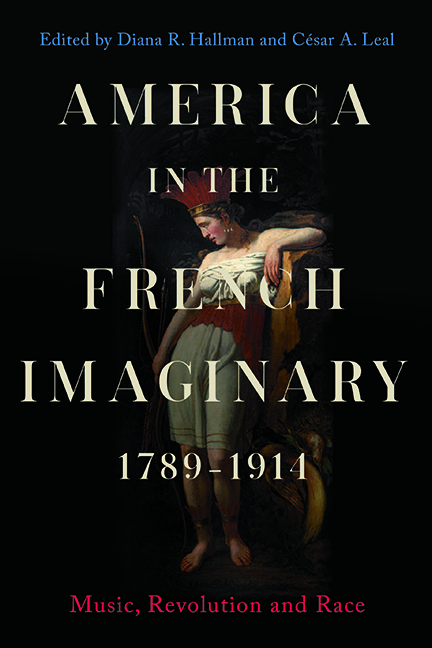Book contents
- Frontmatter
- Dedication
- Contents
- List of Illustrations
- List of Music Examples
- List of Abbreviations
- Editorial Notes
- List of Contributors
- Acknowledgements
- Preface
- Introduction
- Part I American liberté, sauvagerie and esclavage
- Part II Myths of America and Intersecting Identities
- Part III Soundscapes and Sonic Fantasies
- Part IV America, Commodification and Race at the fin de siècle
- Bibliography
- Index
- Music in Society and Culture
Introduction
Published online by Cambridge University Press: 15 September 2022
- Frontmatter
- Dedication
- Contents
- List of Illustrations
- List of Music Examples
- List of Abbreviations
- Editorial Notes
- List of Contributors
- Acknowledgements
- Preface
- Introduction
- Part I American liberté, sauvagerie and esclavage
- Part II Myths of America and Intersecting Identities
- Part III Soundscapes and Sonic Fantasies
- Part IV America, Commodification and Race at the fin de siècle
- Bibliography
- Index
- Music in Society and Culture
Summary
Within the long nineteenth century that frames the first hundred years of the American republic, French writers, artists, and musicians became increasingly enthralled by the young nation's political experiments, vast land-scapes, and diverse culture. Following the American Revolution that upended the rule of British colonial masters (with strategic aid by General Lafayette and his compatriots), French observers often viewed the United States as a laboratory for the forging of new practices of liberté and égalité, in affinity with and as models for France's own revolutionary ideals and experiences. Tributes to American freedom, resiliency, and power and the natural beauty of the New World appeared in many forms, while competing with anti-American depictions of an inferior environment of fetid swamps, sterile deserts, and degenerated animals that had emerged in the influential naturalist writings of Georges Louis Leclerc, Comte de Buffon, and Cornelius De Pauw; these authors’ imagined terrains reverberated with the anti-colonialist views of Enlightenment thinkers such as Voltaire, Denis Diderot, and Guillaume Thomas Raynal. Although acclamations of America as an inspiration of revolution and freedom would peak in the early years of the French Revolution, French encomiums to George Washington and Benjamin Franklin and other symbols of Revolutionary America would continue to appear well into the nineteenth century, as Alexis de Tocqueville's De la démocratie en Amérique (1835) would reinforce the American republic's status as an icon of democracy. The Franco-American bond forged through revolutionary battles and the ‘exchange of revolutionary culture’ would also foster a political and moral rivalry, as proposed by Suzanne Desan. As political tensions rose between the two nations and the French landscape shifted between republican, monarchical, and imperial forms of government, the rivalry could be seen through the reshaping of anti-American tropes of backwardness, savagery, and degeneration in new cultural guises, including those of uncouth frontiersmen, uncultured businessmen, and aesthetically inferior artists and musicians. By the mid- to late nineteenth century, as the American capitalist economy expanded, condescension or revilement of the young country, captured in Baudelaire's condemnations of America's ‘greedy’ materialism, jostled against the promotion of renewed Franco-American alliances. One such coalition, the Union Franco-Amérique, helped to finance France's gift of the Statue of Liberty, erected in 1886 to celebrate, belatedly, the centenary of American independence, to commemorate cultural ties, and perhaps to resurrect shared ideologies between the two nations.
- Type
- Chapter
- Information
- America in the French Imaginary, 1789-1914Music, Revolution and Race, pp. 1 - 12Publisher: Boydell & BrewerPrint publication year: 2022



